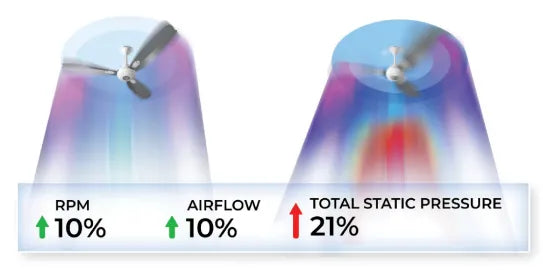

THE HIGH RPM MYTH: AN INSIDER’S PERSPECTIVE ON CHOOSING THE RIGHT CEILING FAN
FROM SUPERFAN, INDIA’S FIRST SUPER ENERGY EFFICIENT CEILING FAN
Comfort is High Flow not High Speed
Introduction
For decades, the Indian ceiling fan industry has pedalled the idea that fans with higher Revolutions Per Minute (RPM) deliver superior thermal comfort. This pervasive belief has shaped the understanding of both consumers and sellers, leading to an oversight of a critical fan specification – airflow, measured in Cubic Meters per Minute (CMM). This misconception is not only depriving consumers of better value but also compromising their overall comfort. Indeed, the pursuit of high RPM in ceiling fans may lead to subtle health discomforts for some consumers. Particularly, individuals with pre-existing breathing issues, some elderly, and those with specific personal preferences may experience excessive moisture evaporation from the eyes and nasal tracts due to the high-speed air. Which could result in morning coughs. Moreover, the constant pressure exerted by the high-speed air may induce muscle stiffness, further impacting overall well-being.
Understanding the Discomfort
To comprehend the discomfort caused by high RPM, it is essential to delve into the basic fan laws. These are a set of established relationships used by engineers and scientists worldwide to describe how changes in fan speed, diameter, and air density affect the performance of a fan. There are three primary fan laws:
The Flow Law: This law states that the flow of air produced by the fan is directly proportional to the speed of the fan. In simpler terms, if the fan speed (RPM) increases by a certain percentage, the airflow also increases by the same percentage.
The Pressure Law: According to this law, the pressure, or the force that the air exerts is directly proportional to the square of the fan speed. This means that if the fan speed increases by a certain percentage, the pressure increases by the square of that percentage.
The Power Law: This law states that the power required by the fan is directly proportional to the cube of the fan speed. So, a small increase in speed can significantly increase the power required.
Applying these laws to our scenario, a 10% increase in RPM does indeed result in a 10% increase in airflow (Flow Law). However, the pressure exerted by the fan also increases by 21% (Pressure Law). This significant rise in pressure under the fan is the root cause of the discomforts previously mentioned. Rapid moisture evaporation and continuous pressure from high-speed air can lead to muscle stiffness and dryness of skin, eyes, and nasal tracts.

Despite higher RPMs initially seeming to create a more refreshing environment, the reality is far more nuanced. The implications of these fan laws significantly affect some individuals’ comfort and well-being, especially those with pre-existing breathing issues, some elderly, and those with specific personal preferences.
A simple example to illustrate that rapid increases evaporation rate is how we blow over a hot cup of tea to cool it down, the faster you blow the tea cools faster, the cooling happens because the hotter molecules of the tea evaporate out of the tea leaving the rest of the tea cooler. This phenomenon is called evaporative cooling and that is how fans cool people. Under the fan one does not always require high evaporation rate one need consistent flow to sustain the evaporative cooling.
The Misconception and its Consequences
The industry’s focus on high RPM fans did not appear out of nowhere. In fact, it was largely driven by an inability of manufacturers to create innovative, efficient blade designs. Constrained by their limitations, manufacturers pedalled the idea of RPM as a measure of fan performance to the consumers and sellers. This strategy, while initially useful in marketing their products, has led to an enduring misconception that persists and has become a constraint.
As a result of this misconception, the airflow measure, mentioned in units Cubic Meter per Minute (CMM), is often overlooked. This critical parameter has been relegated to the background, as the industry, consumers, and sellers alike are still entrenched in the belief that higher RPM is synonymous with superior comfort.
This myth has also led to stagnation in the industry’s performance measurement standards. For decades, these standards remained unchanged, failing to evolve in line with the needs and comfort of the consumers. The lack of innovation and progress has not only limited the variety of fan designs available in the market but also created a barrier for consumers in making informed decisions that consider their personal comfort needs.
The Role of High-Speed Fans
Despite the potential discomforts, it is important to remember that high-speed fans aren’t intrinsically bad. They do have their own niche where their functionality shines. Particularly, they are well-suited for environments that demand rapid thermal comfort, such as lobbies or dining rooms. The high RPM quickly circulates air in the area, providing swift relief from stuffiness or heat, ideal for spaces that are occupied for short periods.

Furthermore, consumer preference plays a significant role in the selection of fans. Some people indeed prefer the sensation of high-speed air, finding it more comforting. This highlights the need for diversity in fan designs and specifications, and not a one-size-fits-all approach.
The goal is not to vilify high-speed fans but to debunk the myth that high RPM is the sole determinant of comfort and efficiency. It is about making consumers aware of the multiple factors that contribute to their thermal comfort, one of which is the fan’s airflow measure. By doing so, consumers can make informed decisions, choosing the fans best suited to their needs and preferences.
Rethinking Comfort with Superfan’s Approach
Superfan revolutionized the ceiling fan industry in 2012 with the launch of India’s first super energy-efficient ceiling fan. We showcased to the industry how a reliable and market-accepting Brushless Direct Current (BLDC) motor-based ceiling fan BLDC can be made, leading the technological transformation in this sector.
As we continued our journey, we realized the issues associated with high-speed fans and directed our focus towards addressing the need for achieving the required airflow at a lower RPM, without resorting to the conventional high-speed fans.
Achieving high airflow at a lower RPM is often simpler with the use of an air foil, a shape designed to obtain a reaction from the air through which it moves. Air foil shapes are seen in everyday life, particularly in airplane wings. If you observe an airplane wing, you will notice it’s thicker on the leading side and thinner on the trailing side. This 3D shape is known as an air foil, and designers modify this shape as per their requirements.
The challenge with using air foil shapes in ceiling fans is that it necessitates the use of moulded plastic for the blades, which significantly increases production costs compared to the predominantly used Aluminium blades in India.
To surmount this challenge, we developed a unique blade shape using thin foil, that is, aluminium sheet, to achieve similar performance as air foil blades. This innovation paved the way for our models, Super Q.
Airflow comprises two elements: air speed and volume. In the case of high-speed fans, the airflow is achieved by moving a small volume of air at high speed. In contrast, high flow fans like Super Q are designed to move a large volume of air at an optimal speed.
For a fan with a span of 1200mm, Super Q is a high flow fan and a testament to innovative blade and motor design. Coupled with our patented super-efficient BLDC motor, Super Q delivers an airflow of 230 CMM, like high-speed fans. However, the RPM of Super Q is significantly reduced to 240, in contrast to the typical high-speed fans which revolve at over 350 RPM. This blade shape also improved the efficiency significantly and consumes only 25 W, making it the most energy-efficient fan in India, a recognition solidified by the ‘Appliance of the Year’ award from the Ministry of Power, Government of India, in 2021.
This unique combination of high flow and low RPM eliminates the discomforts associated with high-speed fans and significantly reduces the noise level. The smooth airflow with lower pressure makes it especially suitable for environments such as bedrooms, living rooms, classrooms, and hospitals. Additionally, the gentle breeze created by Super Q is ideal for air-conditioned rooms, or any setting where people spend extended periods under the fan.
Since the introduction of Super Q, we have been proactive in educating our consumers about the different types of fans and their implications on comfort and well-being. We acknowledge and respect the personal preference of our consumers. It is important to understand that the high-speed air might not be suitable for everyone, especially for individuals with specific health conditions, the elderly, or simply those who prefer a gentle breeze over a gust.
Conclusion
As consumers become more aware and demand healthier, more efficient products, the fan industry needs to step away from the high RPM myth. It is time to focus on creating products that prioritize overall comfort and health. By breaking free from the high RPM misconception, we can pave the way for a new era in the fan industry, where comfort and health are at the forefront of design and selection. Just as we did with our energy-efficient innovations, Superfan is leading the way in this vital aspect of the fan industry.
Note 1: The explanations and claims in the article are empirical, and it is advised that the reader evaluate their own experiences of fans to make an informed decision.
Note 2: As we navigate the future of ceiling fans, understanding the intricacies of high flow and high speed becomes crucial for consumers. High flow, as a term, is generic and can be used in a variety of contexts to denote increased airflow. It is also a common marketing term in the fan industry. Some fans may be marketed as ‘high flow’ but might not deliver the kind of high flow discussed in this article—high volume airflow at optimal speeds. Therefore, it is important for consumers to be cautious while purchasing high flow fans.
Further reading
- https://www.healthline.com/health/sleeping-with-fan-on#:~:text=Concentrated%20circulating%20air%20may%20cause,t%20blow%20directly%20on%20you.
- https://www.healthline.com/health/morning-cough#:~:text=A%20morning%20cough%20can%20occur,irritants%20from%20your%20respiratory%20system.
- https://van.physics.illinois.edu/ask/listing/1471
- https://www.healthline.com/health/sleeping-with-fan-on

